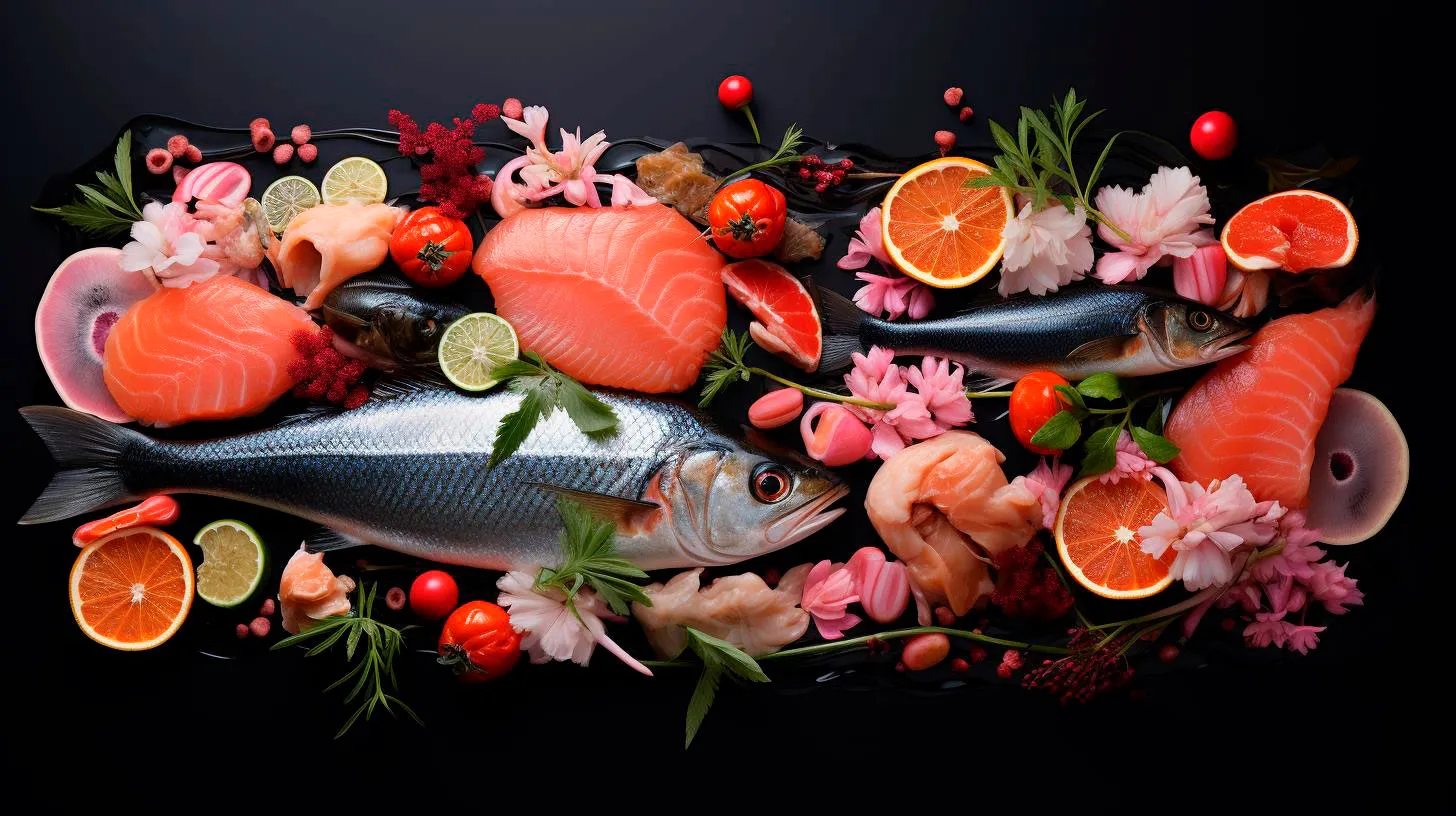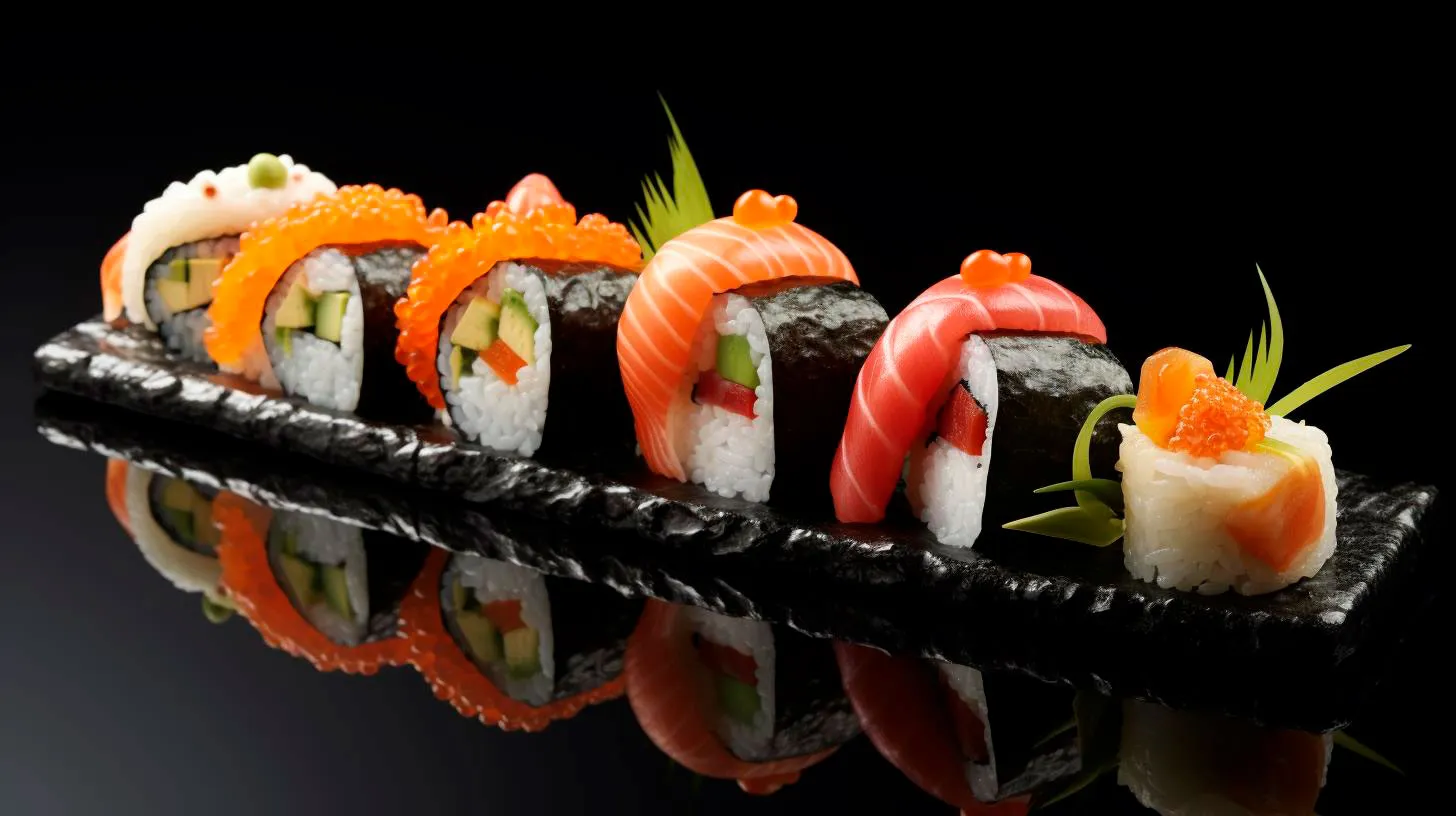Exploring the Health Benefits of Sushi
In this article, we will delve into the health advantages of sushi and explore why it has become a favorite choice for many health-conscious individuals.
A Bite into the Nutritional Composition of Sushi
One of the primary reasons behind sushi’s health benefits lies in its rich nutritional profile. When consumed in moderation, sushi can be a valuable source of essential nutrients, including:
- Omega-3 Fatty Acids: Sushi, often made with fatty fish like salmon, tuna, and mackerel, is an excellent source of omega-3 fatty acids. These fatty acids provide numerous health benefits, such as reducing inflammation, supporting heart health, and promoting brain function.
- Protein: Sushi is typically prepared with seafood and sometimes includes tofu, which adds a valuable protein punch to this dish. Protein is essential for building and repairing tissues, supporting muscle growth, and aiding in various bodily functions.
- Antioxidants: Sushi frequently incorporates vegetables like cucumber, avocado, and seaweed, which are rich in antioxidants. Antioxidants help protect the body against oxidative stress and reduce the risk of chronic diseases such as heart disease and cancer.
- Vitamins and Minerals: Sushi ingredients are often packed with vitamins and minerals, including vitamin A, B vitamins, vitamin C, iodine, and calcium, depending on the specific ingredients used. These nutrients play vital roles in maintaining a healthy immune system, supporting bone health, and promoting overall wellness.
The Advantages of a Low-Calorie Option
For those who are calorie-conscious or trying to maintain a healthy weight, sushi can be a great choice. As sushi is often served as bite-sized pieces, it allows for portion control and enables individuals to keep track of their calorie intake. Additionally, sushi tends to be lower in calories compared to other popular fast food options and Western-style dishes.
For instance, a typical sushi roll made with fish, rice, and nori (seaweed) contains approximately 200-300 calories. In contrast, a fast food hamburger can contain anywhere from 250-500 calories, depending on the ingredients and condiments used. Thus, sushi offers a flavorful alternative with a lower calorie content, making it an attractive option for those aiming to maintain or lose weight.
Supporting Heart Health with Sushi
Heart disease is a leading cause of death worldwide, emphasizing the importance of adopting heart-healthy dietary choices. Certain components of sushi contribute to cardiovascular well-being:
- Omega-3 Fatty Acids: We mentioned earlier that sushi often contains fatty fish rich in omega-3 fatty acids. Regular consumption of omega-3 fatty acids has been associated with a reduced risk of heart disease, as they help lower triglyceride levels, manage blood pressure, and reduce the likelihood of abnormal heart rhythms.
- Low in Unhealthy Fats: Traditional sushi avoids the use of unhealthy fats, such as saturated and trans fats. These unhealthy fats are commonly found in many typical Western-style dishes and can contribute to the development of heart disease if consumed excessively.
- Reduced Sodium: Excess sodium intake can lead to high blood pressure, a risk factor for heart disease. While soy sauce is commonly served alongside sushi, using it in moderation can help limit sodium consumption. Additionally, certain sushi options, like sashimi or rolls with less soy sauce, can further reduce sodium content.
Enjoying Sushi Mindfully
While sushi offers many health benefits, it’s important to consume it mindfully and consider certain factors:
- Quality and Freshness: Opt for sushi made with fresh ingredients to reap the full advantages it offers. Fresh fish is rich in nutrients and ensures a delightful taste experience. Choose reputable sushi establishments to ensure you are enjoying the highest quality sushi.
- Rice and Portion Sizes: Keep in mind that sushi rice is often seasoned with sugar and vinegar, so be mindful of portion sizes to control your carbohydrate intake. Consider opting for brown rice sushi or rolls made with less rice to reduce the overall calorie content.
- Allergies and Dietary Restrictions: Sushi can contain various ingredients that may trigger allergies or not align with specific dietary preferences. Be aware of your individual needs and notify the sushi chef or staff about any allergies or restrictions to ensure a safe and enjoyable dining experience.
In conclusion, sushi not only delights our taste buds but also provides an array of health benefits. Packed with essential nutrients, low in calories, and supporting heart health, sushi offers a delightful and nutritious dining choice. By enjoying sushi mindfully and considering individual needs, it can be an excellent addition to a well-balanced diet. So, the next time you’re craving a culinary adventure, venture into the world of sushi and savor its healthful and mouth-watering wonders!
Top Sushi Restaurants Around the World for Foodies to Try
From traditional and authentic Japanese sushi restaurants to innovative and contemporary sushi hotspots, these establishments offer a unique culinary experience that will leave you craving for more.
1. Sukiyabashi Jiro – Tokyo, Japan
For sushi aficionados, Sukiyabashi Jiro needs no introduction. Nestled in the heart of Tokyo, this legendary sushi restaurant is helmed by Jiro Ono, a master sushi chef with over 70 years of experience. With only ten seats and a focus on omakase-style dining, Jiro’s dedication to perfection is evident in every delicate piece of nigiri he serves.
Key Takeaways:
- Reservations at Sukiyabashi Jiro are notoriously difficult to secure, so plan well in advance.
- The restaurant’s sushi is made with only the highest-quality, freshest ingredients sourced directly from Tsukiji fish market.
- Be prepared to indulge in a multi-course sushi feast, where simplicity and precision are paramount.
2. Sushi Saito – Tokyo, Japan
Another Tokyo gem, Sushi Saito, has earned its place in the sushi hall of fame. Helmed by Takashi Saito, Sushi Saito offers an intimate dining experience that showcases the chef’s unparalleled craftsmanship. From the delicate balance of flavors to the artistry in presentation, each piece of sushi at Sushi Saito is an exquisite masterpiece.
Key Takeaways:
- With just seven seats, scoring a reservation at Sushi Saito is no easy feat.
- The restaurant is known for its commitment to using locally sourced ingredients, resulting in sushi that reflects the flavors of the season.
- Prepare to surrender your palate to an omakase menu curated by Chef Saito himself.
3. Masa – New York City, USA
Located in the heart of New York City, Masa is a sushi destination that needs to be experienced at least once in a lifetime. Chef Masa Takayama’s meticulous attention to detail, combined with his creative flair, elevates sushi to new heights. With a focus on premium ingredients flown in from Japan, Masa offers an indulgent and unforgettable dining experience.
Key Takeaways:
- Masa is often referred to as one of the most expensive restaurants in the world, so be prepared for a luxurious culinary adventure.
- Reservations can be made up to a month in advance, and special dietary requirements can be accommodated upon request.
- Each dish is expertly crafted and presented with the utmost precision, showcasing the chef’s mastery of flavors and textures.
4. Jiro’s Sushi – Ginza, Tokyo
While not directly affiliated with the famous Jiro Ono’s Sukiyabashi Jiro, Jiro’s Sushi in Ginza, Tokyo, has made a name for itself with its own unique interpretation of traditional sushi. Renowned for its affordable yet high-quality sushi, Jiro’s Sushi offers a casual yet authentic dining experience that’s perfect for sushi lovers on a budget.
Key Takeaways:
- Jiro’s Sushi is located in the basement of a Tokyo office building, making it a hidden gem for locals and tourists alike.
- The restaurant is known for its warm and friendly atmosphere, offering a more relaxed alternative to upscale sushi establishments.
- Don’t miss the opportunity to try their signature toro and uni sushi, both highly praised by regulars.
5. Sukiyabashi Jiro Roppongi Hills – Tokyo, Japan
Although not operated by Jiro Ono himself, Sukiyabashi Jiro Roppongi Hills maintains the same dedication to quality and technique that made Sukiyabashi Jiro famous. Located in the upscale Roppongi Hills development, this branch offers a slightly more accessible option for those unable to secure a reservation at the original.
Key Takeaways:
- While reservations are still required, Sukiyabashi Jiro Roppongi Hills is often considered an easier alternative to its elder sibling.
- Expect the same exceptional quality and masterful sushi techniques that have made Sukiyabashi Jiro legendary.
- The omakase menu at this branch offers a well-curated selection of seasonal and traditional sushi.
In Conclusion
If you’re a passionate foodie with an affinity for sushi, these top sushi restaurants around the world are an absolute must-try. From the traditional elegance of Tokyo’s Sukiyabashi Jiro and Sushi Saito to the innovative creations at Masa in New York City, each restaurant offers a unique sushi experience that will transport your taste buds to a whole new level.
So, embark on a culinary adventure and immerse yourself in the artistry, flavors, and craftsmanship that define the world of sushi. Whether you’re a globetrotting gourmet or a local looking for the ultimate sushi hotspot, these renowned establishments will undoubtedly leave an indelible impression on your palate.
The History and Artistry Behind Sushi-Making
In this article, we will explore the rich history and intricate artistry that has made sushi a beloved global sensation.
The Origins of Sushi
Sushi, as we know it today, traces its origins back to ancient Japan. However, its roots can be traced even further back, to Southeast Asia, where people used to ferment fish in rice to preserve it. This fermentation process allowed the fish to be stored for extended periods, becoming a staple food for fishermen and travelers.
Over time, this preparation method made its way to Japan, where the Japanese people refined the technique and added their own unique touch. Originally, the dish was consumed only by the aristocracy and was considered a delicacy. But as Japan went through periods of urbanization, sushi became more accessible to the masses.
The Evolution of Sushi
As sushi gained popularity, different variations began to emerge. Two distinctive types of sushi were developed:
-
Nigiri Sushi:
Nigiri sushi is a hand-pressed form of sushi made of vinegared rice topped with various ingredients like raw fish, shellfish, or vegetables. It is often served with a small amount of wasabi between the rice and the topping. Nigiri sushi showcases the delicate balance of flavors that sushi is renowned for.
-
Maki Sushi:
Maki sushi, also known as sushi rolls, is made by wrapping vinegared rice, fillings, and seaweed (nori) in a cylindrical shape. It is then cut into bite-sized pieces. Maki sushi allows for a variety of fillings, including fish, vegetables, and even tempura. This style of sushi offers both visual appeal and a delightful combination of textures.
With the advent of refrigeration and advancements in transportation, sushi started to evolve even further. In the 1970s, the popularization of sushi bars and the introduction of innovative techniques like the California roll, which incorporated avocado and crab, propelled sushi to new heights of popularity in the Western world.
The Artistry of Sushi-Making
Creating sushi is not merely about assembling ingredients. It is an art form that requires skill, precision, and attention to detail. A sushi chef, also known as a itamae, undergoes years of training to master this craft. Here are some key elements of the artistry behind sushi-making:
-
Knife Skills:
The itamae’s knife skills are crucial to create precise cuts and shapes. With a single stroke, the itamae can transform a fillet of fish into a delicate, visually appealing topping.
-
Seasoning:
The itamae carefully seasons the rice with a mixture of vinegar, salt, and sugar. This step is essential to achieve the perfect balance of flavors in each bite.
-
Presentation:
Visual presentation is paramount in sushi-making. The itamae strives to create beautiful and harmonious arrangements of colors and textures on the plate, ensuring that each piece is a work of art.
-
Attention to Detail:
No detail is too small for the itamae. From the temperature of the rice to the composition of flavors, every aspect of sushi-making is meticulously considered.
Key Takeaways
Sushi’s journey from a preservation method to a world-renowned delicacy is a testament to its enduring appeal. Here are some key takeaways to remember about the history and artistry behind sushi-making:
- Sushi originated in Southeast Asia and evolved over time in Japan into the iconic dish we know today.
- Nigiri sushi and maki sushi are two popular forms of sushi, each offering unique flavors and textures.
- In recent decades, sushi has gained tremendous popularity globally, thanks to its accessibility and innovative variations.
- The artistry of sushi-making lies in the itamae’s knife skills, seasoning techniques, attention to detail, and visual presentation.
So the next time you indulge in a plate of sushi, take a moment to appreciate the centuries of history and artistry that have contributed to its exquisite taste and visual splendor. Sushi truly represents the intersection of culinary craftsmanship and cultural heritage.
Must-Have Ingredients for Sushi Enthusiasts
To help you get started, we have compiled a list of must-have ingredients for sushi enthusiasts. From the freshest fish to the essential condiments, these ingredients are key in creating authentic and delicious sushi rolls.
1. Sushi Rice
Let’s start with the foundation of any good sushi roll – the rice. Sushi rice is short-grained rice that is sticky and slightly sweet. It is essential to use sushi rice as it holds the ingredients together and provides that characteristic texture. When cooking sushi rice, make sure to rinse it thoroughly to remove any excess starch. A rice cooker can also be handy in achieving perfectly cooked, sticky rice.
2. Fresh Fish and Seafood
No sushi roll is complete without the addition of fresh fish or seafood. The most commonly used fish for sushi include salmon, tuna, yellowtail, and shrimp. When buying fish for sushi, always ensure that it is sushi-grade, which means it has been handled and stored properly to minimize the risk of any foodborne illnesses. Additionally, you can experiment with other seafood options such as crab, scallops, or even eel to add variety to your sushi creations.
3. Nori Seaweed Sheets
Nori, or dried seaweed sheets, is another essential ingredient in sushi making. It is used to wrap the rice and fillings, giving sushi rolls their signature appearance. Nori is available in sheets or smaller strips, making it convenient to use. Look for high-quality nori that is crisp and dark in color for the best results.
4. Vegetables and Fillings
While fish and seafood take the spotlight in sushi, vegetables play an equally important role in adding texture and flavor. Some popular sushi fillings include cucumber, avocado, carrots, and daikon radish. These fresh vegetables add crunch and a burst of color to your rolls. Experiment with different combinations to discover your favorite vegetable fillings.
5. Soy Sauce and Wasabi
No sushi experience is complete without the classic combination of soy sauce and wasabi. Soy sauce adds a savory touch to your roll, while wasabi provides a fiery kick. Opt for low-sodium soy sauce if you prefer a milder taste. Wasabi, a spicy green paste made from horseradish, adds a zing to each bite of sushi. Be cautious, as it can be quite strong!
6. Pickled Ginger
Pickled ginger, also known as gari, is a palate cleanser often served with sushi. It has a slightly sweet and tangy taste, helping to refresh your taste buds between bites. Its pink color adds a vibrant touch to your sushi plate.
Key Takeaways
- Ensure you use sushi rice, as it is sticky and holds the ingredients together.
- Invest in high-quality and sushi-grade fish and seafood for the freshest flavors.
- Use crisp and dark nori seaweed sheets for the best appearance of your rolls.
- Experiment with a variety of vegetables and fillings to add texture and flavor to your rolls.
- Pair your sushi with soy sauce and wasabi for a savory and spicy touch.
- Include pickled ginger as a palate cleanser to refresh your taste buds.
Now that you are equipped with the must-have ingredients for sushi enthusiasts, it’s time to unleash your creativity and start making your own sushi masterpieces. Remember to have fun, experiment with different ingredients, and most importantly, enjoy the delicious results of your sushi-making endeavors!



